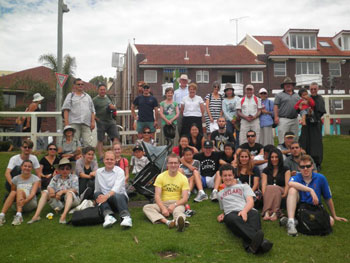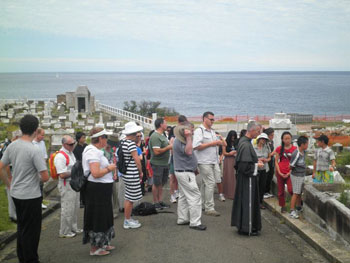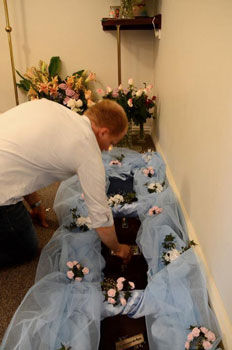Inspired by her faith, courage, commitment and love of God, men and women of all ages joined together last week on a pilgrimage to commemorate the life and legacy of Eileen O’Connor.
On 10 January, the 91st anniversary of the young woman’s death, the group celebrated with their annual walk and Benediction at St Anne’s Catholic Church, Bondi. The group which included Father Terence Mary Naughtin OFM, began the 10 kilometre coastal walk from Bondi to the convent of Our Lady’s Nurses of the Poor at Coogee.
The tomb of Eileen O’Connor lies inside the convent’s chapel, where each year on the anniversary of her death, the congregation she founded, remove the top of the vault to reveal her coffin. The rim of the vault is then surrounded by flowers and it has become a tradition for pilgrims who come to pray beside the tomb to commemorate the anniversary of her death by laying rosary beads on her coffin.
Last week as well as the group of pilgrims who walked from Bondi to pray at her tomb, others arrived from throughout Coogee and the surrounding area to pay their respects and honour the woman regarded as one of Australia’s saints-in-waiting who is often known as “the saint by the seaside.”
Born Eily Rosaline O’Connor, Eileen as she was known, was born on 19 February 1892 in Melbourne. The eldest of four to Irish parents, she was three years old when she fell from her pram and severely damaged her spine. Despite many operations, nothing could be done to alleviate the terrible pain, and later when X-rays could be taken, it was discovered her spine had been pushed out of alignment to an angle of 80 degrees.

The deformity should have prevented Eileen from walking, but with typical perseverance and courage, and despite intense and continuous pain, she managed to stand and at times even walk. But for the most part during her childhood, she was bedridden or needed help to move.
Although she was enrolled at Richmond parish school, her disability and the intense pain meant she was often too ill, and with few friends of her own age and little opportunity for the normal preoccupations of childhood, she turned to her family and her religion for comfort.
At age 10, she moved with her family to Sydney where he had been offered a job as a senior clerk. Surgical and medical treatment for Eileen continued. But these were a drain on family resources and when her father died suddenly in 1911, the family faced financial hardship. Coogee parish priest, Fr Edward McGrath found accommodation for the family and witnessed the courage of the then 19-year-old Eileen, who coped with pain so severe that at times she would collapse unconscious.

Deeply religious, Eileen claimed to have received a visitation from the Holy Mother who encouraged her to accept her suffering for the good of others. She told only Fr McGrath of this vision and he in turn shared with her his ambition to establish a congregation of nurses to serve the poor. Eileen was filled with enthusiasm for the venture and moved into a rented house in Coogee in 1915 – which would become known as Our Lady’s Home and serve as the convent for the new congregation.
Despite her disability, Eileen was a tireless worker and inspirational leader, and when the community of “Our Lady’s Nurses of the Poor,” elected her as the congregation’s first superior there was little surprise. The work of the Brown Nurses as they became known consisted of visiting the poor who were sick in their own homes and nursing them and also caring for the frail and aged.
Eileen supervised the work and directed the spiritual development of the congregation. But when a group of Sacred Heart Missionaries alleged an improper relationship between Eileen and co-founder of the congregation, Fr McGrath found himself banned from officiating as a priest. He appealed to Rome. Eileen, so incensed at such outrageous claims, and with the assistance of a nurse travelled to the Vatican in 1911 in support of his cause. Granted an interview with Pope Benedict XV she influenced his decision to reinstate Fr McGrath.

Returning to Australia, she continued to be an inspiring devoted leader of her congregation, but by now was almost entirely bedridden. Ill health continued to dog her and after years of suffering chronic tuberculosis of the spine, she died on 10 January 1921.
Just 29 years old she was buried at Randwick cemetery. Sixteen years later when her body was exhumed to be reinterred beneath the chapel at the convent Our Lady’s Nurses of the Poor, it was found to be in a state of perfect preservation.
“I was talking with a friend and she mentioned Eileen O’Connor. I’d never heard of her. But I did some research and discovered she was an ‘incorruptible’ and then I started reading her meditations and discovered what a wonderful model of courage, selflessness and true faith she had been,” says Ronan Reilly who has organised pilgrimage walks from Bondi to Eileen O’Connor’s tomb for the past three years.
This year’s pilgrim walk on the anniversary of her death concluded with high Mass celebrated by Fr Terence Mary McNaughtin inside the chapel of the convent of Our Lady’s Nurses of the Poor.
Ronan is keen for others to know about Eileen O’Connor and hopes that one day, like St Mary of the Cross MacKillop, she will be recognised fully for her holiness and selfless devotion to God and become a candidate for sainthood.
